- Joined
- Feb 2, 2013
- Messages
- 3,625
I have a wonderful South Bend 14" Drill Press that i got from fellow member @TAWP Tool 
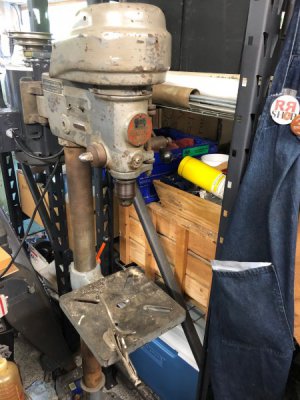
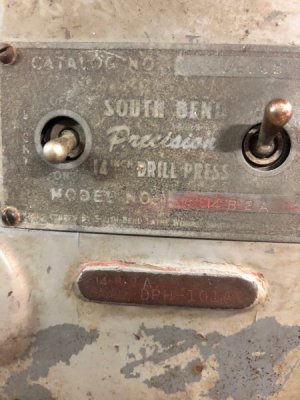
i tried to utilize the drill press with just the OEM pulleys from the 56 frame 1725 rpm, 1/2 Hp motor @115v, for a couple years-
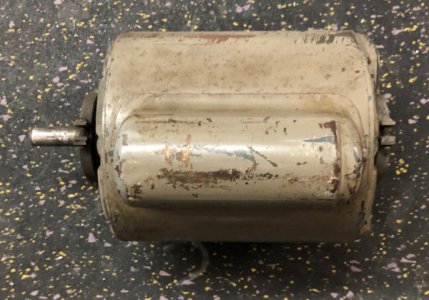
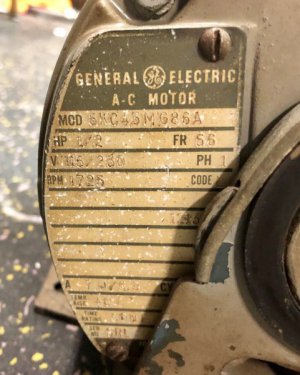
but the spindle was turning waaay too fast for my taste or use. (even in the slowest speeds possible) for much more than a 5/16 drill bit.
for woodworking and soft materials it was sweet to use,
large bits were out of the question.
i'm aware that there was another pulley arrangement available that gave more speed reduction,
but i was looking for a simpler answer...
through sheer luck, i was able to procure a 56 frame 1140 rpm, 3/4Hp motor @115v (inexpensively ),
),
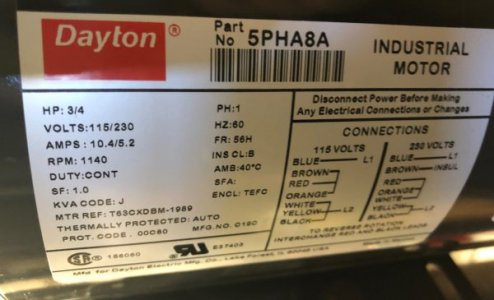

i decided to use the stock pulley arrangement without further reduction.
i decided to calculate the approximate spindle speeds given what information i have available
the drive and driven pulleys are thankfully just inverted versions of themselves, giving 4 different possible speeds.
largest step 5.125" OD
next step 4.125" OD
next step 3.125" OD
smallest step 2.125"
to my best estimation, here were the old spindle speeds on the 1725 rpm motor arrangement
with the speed arrangement set to the lowest possible spindle speed, then increasing for each subsequent step
here is the reduction multipliers i used with the given 1725 RPM
step 1- { 2.412
step 2- { 1.321
step 3- { .758
step 4- { .415
Spindle Speeds:
716 RPM
1,308 RPM
2,279 RPM
4,161 RPM
after doing the calculations on the 1140 rpm motor arrangement,
you'll see there is a wonderful reduction
i used the same multipliers, but inserted the given as the 1140 rpm
New Spindle Speeds !:
!:
473 RPM -243 RPM -33.9%
864 RPM -443 RPM -33.9%
1,506 RPM -773 RPM -33.9%
2,7450 RPM -1,411 RPM -33.9% from the OEM arrangement YIPPEE!!!!!
I used a string wrapped around the pulleys in the low speed position to estimate the belt size,
i ended up with a 4L460 belt and it fits like a glove!
the wire up was simple and went easy to install!
Here is some pic's of the motor as installed,
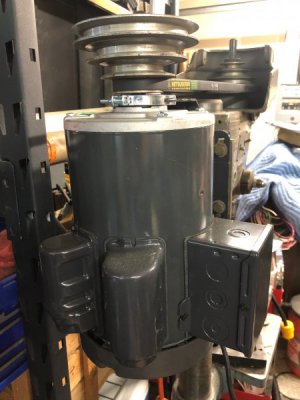
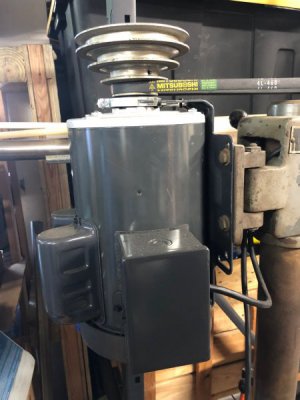
i'll be testing over the next couple weeks.
i already like the speed reduction
as always thanks for reading



i tried to utilize the drill press with just the OEM pulleys from the 56 frame 1725 rpm, 1/2 Hp motor @115v, for a couple years-


but the spindle was turning waaay too fast for my taste or use. (even in the slowest speeds possible) for much more than a 5/16 drill bit.
for woodworking and soft materials it was sweet to use,
large bits were out of the question.
i'm aware that there was another pulley arrangement available that gave more speed reduction,
but i was looking for a simpler answer...
through sheer luck, i was able to procure a 56 frame 1140 rpm, 3/4Hp motor @115v (inexpensively
 ),
),

i decided to use the stock pulley arrangement without further reduction.
i decided to calculate the approximate spindle speeds given what information i have available
the drive and driven pulleys are thankfully just inverted versions of themselves, giving 4 different possible speeds.
largest step 5.125" OD
next step 4.125" OD
next step 3.125" OD
smallest step 2.125"
to my best estimation, here were the old spindle speeds on the 1725 rpm motor arrangement
with the speed arrangement set to the lowest possible spindle speed, then increasing for each subsequent step
here is the reduction multipliers i used with the given 1725 RPM
step 1- { 2.412
step 2- { 1.321
step 3- { .758
step 4- { .415
Spindle Speeds:
716 RPM
1,308 RPM
2,279 RPM
4,161 RPM
after doing the calculations on the 1140 rpm motor arrangement,
you'll see there is a wonderful reduction

i used the same multipliers, but inserted the given as the 1140 rpm
New Spindle Speeds
 !:
!:473 RPM -243 RPM -33.9%
864 RPM -443 RPM -33.9%
1,506 RPM -773 RPM -33.9%
2,7450 RPM -1,411 RPM -33.9% from the OEM arrangement YIPPEE!!!!!
I used a string wrapped around the pulleys in the low speed position to estimate the belt size,
i ended up with a 4L460 belt and it fits like a glove!
the wire up was simple and went easy to install!
Here is some pic's of the motor as installed,


i'll be testing over the next couple weeks.
i already like the speed reduction
as always thanks for reading
Last edited:


